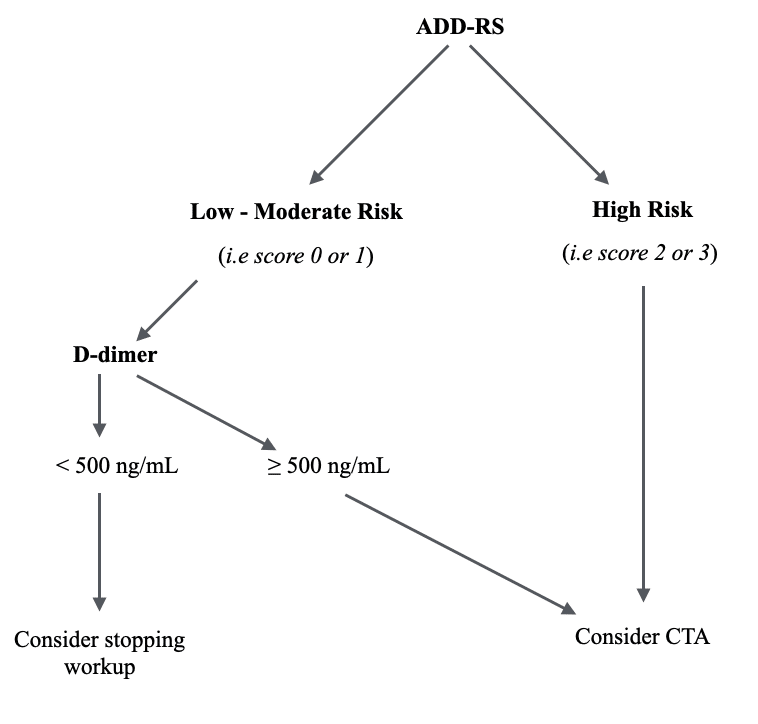Aortic Dissection Detection Risk Score (ADD-RS)
The Aortic Dissection Detection Risk Score (ADD-RS) is a validated scoring system that helps stratify low to moderate risk patients who may have an aortic dissection. It is typically used in conjunction with a D-dimer value to guide decisions on the need for aortic imaging.
While the ADD-RS has been validated, the combined ADD-RS + D-dimer algorithm (e.g. the ADvISED study algorithm) has not yet been externally validated for ruling out acute aortic dissection. Therefore, although useful, the scoring system should be used with caution.
Importantly, the ADD-RS and D-dimer are not intended to diagnose acute aortic syndrome (AAS), but rather to assist in risk stratification and guide the need for definitive imaging.
Scoring Method
In general, the more high-risk findings a patient exhibits that are consistent with acute aortic dissection, the higher the likelihood of the diagnosis.
High-risk factors are grouped into three categories:
1. High Risk Predisposing Conditions
- Marfan’s syndrome (or other connective tissue disease)
- Family history of aortic disease
- Known aortic valve disease
- Recent aortic manipulation
- Known thoracic aortic aneurysm
2. High Risk Pain Characteristics
Chest, back, or abdominal pain that is:
- Abrupt in onset and/or severe in intensity
AND - Tearing, ripping, or sharp in quality (suggesting pleuritic rather than visceral pain)
3. High Risk Examination Findings
- Perfusion deficit:
- Pulse deficit
- Systolic blood pressure differential
- Focal neurological deficit (in conjunction with pain)
- New aortic insufficiency murmur (in conjunction with pain)
- Hypotension or shocked state
Risk Score Interpretation
The ADD-RS score is determined by the number of categories (0–3) in which any risk factor is present.
| ADD-RS | Interpretation | Approx. % of AD cases |
|---|---|---|
| 0 | Low risk | ~4% |
| 1 | Moderate risk | ~36% |
| 2–3 | High risk | ~60% |
Note: A score of 0 does not completely rule out dissection but indicates a substantially lower probability.
Diagnostic Guidance
- High Risk (ADD-RS 2–3):
Proceed directly to CTA or other definitive imaging. - Low to Moderate Risk (ADD-RS 0–1):
Use D-dimer to further refine risk:- D-dimer < 500 ng/mL: Consider stopping workup for aortic dissection.
- D-dimer ≥ 500 ng/mL: Consider CTA.

References
Publications
- Rogers AM, Hermann LK, Booher AM, Nienaber CA, Williams DM, Kazerooni EA, Froehlich JB, O’Gara PT, Montgomery DG, Cooper JV, Harris KM, Hutchison S, Evangelista A, Isselbacher EM, Eagle KA; IRAD Investigators. Sensitivity of the aortic dissection detection risk score, a novel guideline-based tool for identification of acute aortic dissection at initial presentation: results from the international registry of acute aortic dissection. Circulation. 2011 May 24;123(20):2213-8.
- Nazerian P, Mueller C, Soeiro AM, Leidel BA, Salvadeo SAT, Giachino F, Vanni S, Grimm K, Oliveira MT Jr, Pivetta E, Lupia E, Grifoni S, Morello F; ADvISED Investigators. Diagnostic Accuracy of the Aortic Dissection Detection Risk Score Plus D-Dimer for Acute Aortic Syndromes: The ADvISED Prospective Multicenter Study. Circulation. 2018 Jan 16;137(3):250-258.
FOAMed
- Nickson C. Acute Aortic Dissection. LITFL
- Nickson C. Aortic Dissection Echocardiography. LITFL
- Beech G. CT Case 006. LITFL
- Lam L. CT Case 034. LITFL
- Nazerian P. Aortic Dissection Detection Risk Score (ADD-RS). MDCalc
Fellowship Notes
Educator, magister, munus exemplar, dicata in agro subitis medicina et discrimine cura | FFS |

